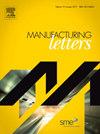A non-iterative compensation method for machining errors of thin-walled parts considering coupling effect of tool-workpiece deformation
IF 1.9
Q3 ENGINEERING, MANUFACTURING
引用次数: 0
Abstract
Thin-walled parts have significant application value in the aerospace industry due to their high strength-to-weight ratio. However, their low rigidity makes them susceptible to cutting force-induced error, which may seriously affect their machining accuracy. Error compensation is an effective method for addressing this issue. However, the commonly used mirror compensation method can cause residual errors due to the coupling effect of the tool-workpiece deformation. The influence mechanism of this coupling effect on error compensation is analyzed through an iterative compensation method. This method efficiently reduces residual errors. However, its computation efficiency is insufficient to meet the requirements of real-time compensation. Therefore, a non-iterative compensation method is proposed to directly calculate the compensation values considering the coupling effect of the tool-workpiece deformation. Through the approximate invariance of the overall cutting coefficient matrix and the pre-given system parameter, the proposed method avoids the repeated calculation of cutting forces and improves the computation efficiency. Experiment results of milling thin-walled blades show that after compensation using the proposed method, the machining accuracy of the thin-walled blade has seen a further increase of 18.1% in comparison to the mirror compensation method. Moreover, the proposed method achieves comparable compensation accuracy to the iterative method with a 66% reduction in computation time. The proposed method has significant potential for real-time compensation in the machining of complex 5-axis thin-walled parts.
考虑刀具-工件变形耦合效应的薄壁零件加工误差非迭代补偿方法
薄壁零件因其高强度重量比而在航空航天工业中具有重要的应用价值。然而,由于其刚性较低,很容易受到切削力引起的误差影响,从而严重影响其加工精度。误差补偿是解决这一问题的有效方法。然而,由于刀具与工件变形的耦合效应,常用的镜面补偿方法可能会导致残余误差。本文通过一种迭代补偿方法分析了这种耦合效应对误差补偿的影响机制。该方法可有效减少残余误差。然而,其计算效率不足以满足实时补偿的要求。因此,我们提出了一种非迭代补偿方法,考虑到刀具和工件变形的耦合效应,直接计算补偿值。该方法通过整体切削系数矩阵的近似不变性和预先给定的系统参数,避免了切削力的重复计算,提高了计算效率。铣削薄壁叶片的实验结果表明,使用所提出的方法进行补偿后,薄壁叶片的加工精度比镜面补偿法进一步提高了 18.1%。此外,所提方法的补偿精度与迭代法相当,而计算时间却减少了 66%。所提出的方法在复杂五轴薄壁零件加工的实时补偿方面具有巨大潜力。
本文章由计算机程序翻译,如有差异,请以英文原文为准。
求助全文
约1分钟内获得全文
求助全文
来源期刊

Manufacturing Letters
Engineering-Industrial and Manufacturing Engineering
CiteScore
4.20
自引率
5.10%
发文量
192
审稿时长
60 days
 求助内容:
求助内容: 应助结果提醒方式:
应助结果提醒方式:


